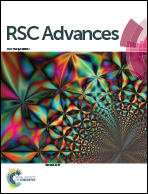Heterostructured Bi2S3@NH2-MIL-125(Ti) nanocomposite as a bifunctional photocatalyst for Cr(vi) reduction and rhodamine B degradation under visible light†
Abstract
A series of bismuth sulfide (Bi2S3) nanorods and amine-functionalized Ti-based metal–organic framework heterojunctions [denoted by Bi2S3@NH2-MIL-125(Ti)] were constructed and explored as bifunctional photocatalysts for Cr(VI) reduction and rhodamine B (RhB) degradation under visible light illumination. Compared with the individual NH2-MIL-125(Ti) and Bi2S3, the as-synthesized Bi2S3@NH2-MIL-125(Ti) photocatalyst exhibited an enhanced photocatalytic activity toward Cr(VI) and RhB owning to the synergetic effect between Bi2S3 and NH2-MIL-125(Ti). Moreover, the Bi2S3@NH2-MIL-125(Ti) heterojunctions showed increased Cr(VI) removal efficiency by adding RhB in the system. The photocatalytic mechanism was proposed based on the analysis of different scavenger for active species and electron spin resonance spectrometry. The introduction of Bi2S3 into NH2-MIL-125(Ti) can extend the light adsorption and improve the transfer and separation of photogenerated charge carriers through the Bi2S3@NH2-MIL-125(Ti) heterojunction with unique band gap structure. The synthesized Bi2S3@NH2-MIL-125(Ti) photocatalyst also exhibited good reusability and stability.



 Please wait while we load your content...
Please wait while we load your content...